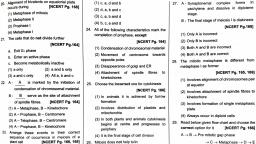Page 1 :
|, {, , , , a ‘Most t dramatic period of cell cycle, , > Chromosome number in parent and progeny cells is the same hence, , KARYOKINESIS, , called ae eee eee, , 1. PROPHASE, , 2. METAPHASE, , 2 First phase, follows the S and G, 2 The complete disintegration of the, , of interphase., , Marked by the initiation of, , condensation of chromosomal, , material which becomes, untangled., , Centrosome starts to move, , towards opposite poles., , The completion of prophase can be, , marked by, (i) Chromosomes condense to, form compact mitotic, chromosome., , (i) Each centrosome reach at pole, and radiates out microtubules, called asters. The two asters, together with spindle fibres, form mitotic apparatus., , G, , 9, , °, , > At the end of prophase ceils do not, show Goigi complex, ER, nucleolus °, , and nuclear envelope., , nuclear envelope marks the start of, metaphase., , . Condensation of chromosomes is, , completed and can be observed, clearly under microscope and, morphology of chromosomes is, most easily studied., , Each chromosome has two sister, chromatids which are held, together by the centromere., , All the chromosome coming to lie, at equator., , Each chromosome connected by, its kinetochore to spindle fibre from, one pole and its sister chromatid, connected by its kinetochore to, spindle fibre from the opposite, pole., , The plane of alignment of the, chromosomes at metaphase is, referred to as metaphase plate., , , , (a), , , , (b), Metaphase, , , , , (5) M PHASE (MITOSIS), , Divided into, , 3. ANAPHASE, , 2 Centromere of each chromosome, , split simultaneously and, chromatids separate., , Two daughter chromatids, now, referred to as daughter, chromosome begin their migration, towards the two opposite poles., The centromere of each, chromosome remain directed, towards the pole and arms trailing, behind. (leading to different, shapes of chromosomes), , 3, , °, , 4. TELOPHASE, Final stage of karyokinesis., Chromosomes that have, reached their respective, poles decondense and lose, their individuality., Nuclear envelope develops, around the chromosome, cluster at each pole forming, two daughter nuclei., Nucleolus, Golgi complex, and ER reform., , , , Anaphase, , Telophase, , , , (6) SIGNIFICANCE OF MITOSIS, , , , , , CYTOKINESIS, It is division of cytoplasm at the, end of which cell division gets, completed., , In animal cells it is achieved by sl, appearance of a furrow in the |, plasma membrane. |, In plant cells cytokinesis is), achieved by wall formation, which |, starts in the centre of the cell and!, grows outward to meet the!, existing lateral wall., The formation of new cell wall:, begins with the formation of a, simple precursor, called the cell, plate that represents the middle, lamella between the wall of two, adjacent cells., , When karyokinesis is not followed |, by cytokinesis as a result of which, multinucleate condition arises;, leading to formation of syncytium, ,, eg. liquid endosperm in coconut. |, , , , Kinetochore is disc shaped, structure at the surface of |, centromere, serves as the |, site of attachment of spindle |, fibres, , , , 2 Mitosis usually results in identical genetic complement in daughter cells., , 2 Growth of multicellular organisms., , 2 Cellrepair, , >» Mitotic division in apical and lateral meristem results continuous growth of plants throughout their life., 2 Insome lower plants and in some social insects haploid cells also divide by mitosis., , avin aa Ses peered”
































































